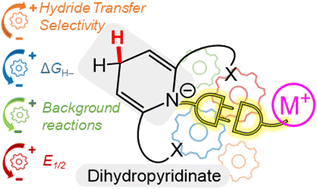Metallated dihydropyridinates: prospects in hydride transfer and (electro)catalysis
Abstract
Hydride transfer (HT) is a fundamental step in a wide range of reaction pathways, including those mediated by dihydropyridinates (DHP−s). Coordination of ions directly to the pyridine ring or functional groups stemming therefrom, provides a powerful approach for influencing the electronic structure and in turn HT chemistry. Much of the work in this area is inspired by the chemistry of bioinorganic systems including NADH. Coordination of metal ions to pyridines lowers the electron density in the pyridine ring and lowers the reduction potential: lower-energy reactions and enhanced selectivity are two outcomes from these modifications. Herein, we discuss approaches for the preparation of DHP–metal complexes and selected examples of their reactivity. We suggest further areas in which these metallated DHP−s could be developed and applied in synthesis and catalysis.

- This article is part of the themed collections: Most popular 2023 inorganic chemistry articles, 2023 Chemical Science Perspective & Review Collection and 2023 Chemical Science HOT Article Collection


 Please wait while we load your content...
Please wait while we load your content...